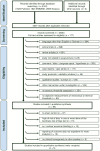Effects of acupuncture on sensory perception: a systematic review and meta-analysis
- PMID: 25502787
- PMCID: PMC4264748
- DOI: 10.1371/journal.pone.0113731
Effects of acupuncture on sensory perception: a systematic review and meta-analysis
Abstract
Background: The effect of acupuncture on sensory perception has never been systematically reviewed; although, studies on acupuncture mechanisms are frequently based on the idea that changes in sensory thresholds reflect its effect on the nervous system.
Methods: Pubmed, EMBASE and Scopus were screened for studies investigating the effect of acupuncture on thermal or mechanical detection or pain thresholds in humans published in English or German. A meta-analysis of high quality studies was performed.
Results: Out of 3007 identified articles 85 were included. Sixty five studies showed that acupuncture affects at least one sensory threshold. Most studies assessed the pressure pain threshold of which 80% reported an increase after acupuncture. Significant short- and long-term effects on the pressure pain threshold in pain patients were revealed by two meta-analyses including four and two high quality studies, respectively. In over 60% of studies, acupuncture reduced sensitivity to noxious thermal stimuli, but measuring methods might influence results. Few but consistent data indicate that acupuncture reduces pin-prick like pain but not mechanical detection. Results on thermal detection are heterogeneous. Sensory threshold changes were equally frequent reported after manual acupuncture as after electroacupuncture. Among 48 sham-controlled studies, 25 showed stronger effects on sensory thresholds through verum than through sham acupuncture, but in 9 studies significant threshold changes were also observed after sham acupuncture. Overall, there is a lack of high quality acupuncture studies applying comprehensive assessments of sensory perception.
Conclusions: Our findings indicate that acupuncture affects sensory perception. Results are most compelling for the pressure pain threshold, especially in pain conditions associated with tenderness. Sham acupuncture can also cause such effects. Future studies should incorporate comprehensive, standardized assessments of sensory profiles in order to fully characterize its effect on sensory perception and to explore the predictive value of sensory profiles for the effectiveness of acupuncture.
Conflict of interest statement
Figures



References
-
- Barnes PM, Bloom B, Nahin RL (2008) Complementary and alternative medicine use among adults and children: United States, 2007. Natl Health Stat Report: 1–23. - PubMed
-
- Eardley S, Bishop FL, Prescott P, Cardini F, Brinkhaus B, et al. (2012) A Systematic Literature Review of Complementary and Alternative Medicine Prevalence in EU. Forsch Komplementmed 19 Suppl 218–28. - PubMed
-
- Lee JH, Choi TY, Lee MS, Lee H, Shin BC (2013) Acupuncture for acute low back pain: a systematic review. Clin J Pain 29:172–185. - PubMed
-
- Smith CA, Zhu X, He L, Song J (2011) Acupuncture for primary dysmenorrhoea. Cochrane Database Syst Rev: CD007854. - PubMed
Publication types
MeSH terms
LinkOut - more resources
Full Text Sources
Other Literature Sources
Medical

